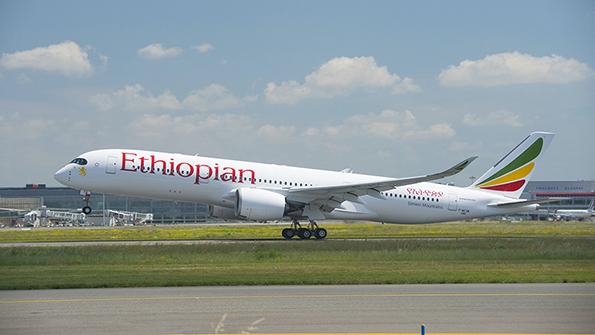
All regions face a steep uphill climb from the COVID-19 crisis, but the starting point for African carriers is much further down the mountain. Most were loss-making before the pandemic and are ill-equipped for the tough journey that will continue through 2021.
Africa makes up 20.3% of the world’s landmass, but African airlines carry just 2.1% of world airline traffic. Conversely, Europe has 6.7% landmass and 26.8% of worldwide RPKs. The high level of connectivity that other continents lost to COVID did not exist in Africa to begin with.
IATA figures show African traffic was down 90.1% in August, causing load factors to fall 41 points to just 34.6%, the lowest of any region.
“Since July, we have seen a restart of activities from our members, but the level of activity is still very, very low,” African Airlines Association (AFRAA) secretary general Abdérahmane Berthé told ATW. “We have not yet attained 50% of traffic compared to 2019. We only have 73 routes which have reopened since September.”
This has hit the finances AFRAA’s 45 member airlines.
“Before COVID-19, African airlines were losing money. They were not profitable. COVID-19 is aggravating this situation and they are losing more money,” Berthé said. “Today, the real challenge is a liquidity crisis.”
AFRAA polled its members and just 16 airlines had a total of $3.2 billion in debt. The association is working with the African Union (AU) and the African Civil Aviation Commission (AFCAC) to create a $25 billion fund to support Africa’s aviation industry.
“We think that, by January, we can have this fund in place to help restart the business,” Berthé said.
Losing connections
Africa is also facing a connectivity crisis. The continent had sparse connections before the pandemic and many of those remain closed. A patchwork of varying COVID health-screening protocols across Africa, high-cost tests and a lack of mutual recognition between countries is making air travel difficult on the few routes that remain.
AFRAA held a network coordination meeting in October and has set up an interactive capacity-sharing portal to restore some air links. Airlines can use the portal to request, or offer, aircraft capacity. Berthé said this increases daily utilization and allows airlines to open new routes without investing in additional aircraft.
Another initiative that would significantly boost intra-African connectivity is the Single African Air Transport Market (SAATM), which aims to revitalize African liberalization under the legal framework of the Yamoussoukro Decision.
“Before COVID, SAATM implementation was very slow. Today, we have 34 countries that have signed a commitment to SAATM, but only 18 countries have modified their bilateral air service agreements,” Berthé said.
Work on SAATM implementation has continued, despite the crisis, and Berthé sees COVID-19 as a potential catalyst. “We are pushing for that. We think that COVID-19 is showing us that we really need to go towards the single African air transport market.”
Chris Zweigenthal, who heads the Airlines Association of Southern Africa (AASA), said he has “certainly seen moves” from the AU and AFCAC to reenergize SAATM. However, he cautioned that commitment levels among countries that were ready to implement may have changed.
Airlines in South Africa have been particularly hard-hit by the crisis, with three established operators—South African Airways, regional airline SA Express and privately owned Comair—entering business rescue proceedings similar to Chapter 11 bankruptcy restructuring.
“We've only seen four airlines start operating [again] in South Africa: CemAir, Airlink, Mango Airlines and FlySafair. The other three airlines are not operational at the moment,” Zweigenthal said. “I think we just need to wait and see how that will pan out.”
AASA represents a total of 20 airline members. Zweigenthal said these operators are starting to slowly ramp up, but all of them are feeling the pinch.
“I don't think there's an airline now, in South Africa or southern Africa, that will make a profit during this financial year,” he said. “Around the region, we're going to have a loss of around about $1 billion for this year, compared to last year’s $200 million loss. So, not a good situation, hence the importance of getting the recovery started.”
Zweigenthal’s fear is that the real impact of the downturn could come later. By reopening the markets now, it might save airlines from irrecoverable debt levels.
“This year, you probably won't see many casualties. But, when the rubber hits the road and you have to start paying back some of that debt, maybe in 2021, we could start seeing some trouble,” he said.
Ghana-based Africa World Airlines (AWA) is among the carriers that have started their climb toward recovery. AWA restarted domestic operations in May, with one daily flight on each route, and has gradually resumed more frequencies.
“Domestic volume has recovered to 2019 average levels now,” AWA COO Sean Mendis told ATW. “International flights restarted in September and we are now back in all destinations, with two daily flights to Lagos, 4X-weekly to Abuja, 3X-weekly each to Freetown and Monrovia, and 2X-weekly to Abidjan.”
Mendis said many African countries have learned lessons from previous pandemics, putting the continent on track for a “new normal.”
Ethiopian Airlines, a long-time African airline star, has also reopened routes inside Africa and beyond. Ethiopian Airlines Group, the largest aviation group in Africa, even completed a new passenger terminal at its hub Addis Ababa Bole International Airport. The new terminal with has 60 check-in counters, 30 self-check kiosks and an emphasis on biosecurity and biosafety.
Air Transport Action Group (ATAG) estimates 4.5 million African aviation jobs are at risk because of the impact of the pandemic. This is well over half the continent’s 7.7 million aviation-related jobs. From the bottom of the mountain, the climb to loss-making normality looks incredibly steep. The summit of sustained profitability will be an even tougher climb. Not all African airlines will be able to go the distance.



